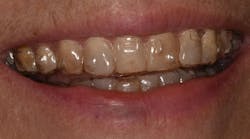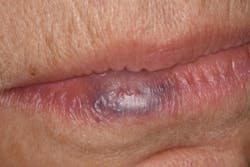The only time the hygienists in my practice argue is when there isn’t another dental laser available. They have seen firsthand how this innovative technology has transformed the practice, and they understand the benefits of using lasers in what they do every day: improved patient outcomes, less outsourcing, and an undeniable return on investment.
Since integrating Biolase dental lasers into my practice, every aspect of everything I do involves a laser. Since instituting dental lasers into my standard of care, my team recognizes the increased joy and renewed passion I have for being a dentist.
Lasers improve patient comfort and results
Not only is the laser useful for numerous dental procedures and treatments; it can also be used on patients of all ages. My patients experience the benefits of advanced laser technology—from more predictable outcomes to gentler procedures to more comfortable healing.
One of the most significant benefits I have seen since implementing lasers is patients’ shifted perspective around treatments. The other day, my patient asked us to use the laser again because he had such a positive experience during his last filling without anesthesia. Using laser technology, the procedure was comparable in duration to that of a high-speed handpiece, and we didn’t have to wait for the anesthesia to set in.
Patients are increasingly interested in the dental technologies we have; they always get excited when they know we are performing the best level of dentistry with advanced technology as a part of their treatment.
Lasers help keep patients in-house
Dental lasers have expanded my practice’s capabilities. I now refer fewer patients to periodontists, oral surgeons, and endodontists, all because my skill set and confidence have improved. With the laser, I can reach and clean canals for endodontics, and I have better visualization for my surgical cases and bone disinfection prior to placing immediate implants. I view each case individually to determine if I can do the procedure as well as a specialist could.
My patients don’t want to go to another practice, drive to another location, see another professional, and spend more money and time on their procedures. While there will always be cases for which the skills of specialists are required (and consequently need to be referred out), having a laser allows me to keep more procedures in-house, which makes my practice more marketable to both current and new patients.
Lasers expand treatment opportunities
Dental laser technology has accelerated my ability to prepare solid treatment plans. With the laser, I can make teeth the length I want them to be and not be limited by the amount of bone present (figure 1). Using an all-tissue laser, I can save teeth I previously would not have been able to due to limitations with conventional tools; advanced technology brings precision. Cutting-edge surgical skills and laser energy allow me to perform certain dental treatments and procedures with greater ease, such as painless root canals, implant placements, and advanced surgical techniques. In the process, my patients get to experience treatments with decreased bleeding, swelling, and pain, which are desirable by-products of laser use.
One new procedure we perform regularly that lasers make possible is periodontal repair, a way to eliminate the cycle of periodontal disease. After a patient goes through periodontal therapy, we can move on to advanced therapy if there are localized areas where damage has already been done. We used to have to refer patients to a specialist for cases like this, and the specialist would have had to cut the gums back, causing major pain. Now, we can keep this procedure in our office and offer a nearly pain-free option using light from the laser.
We can also target multisurface pocket degranulation and debridement of soft and hard tissue with a radial firing tip, reducing infection and decreasing postoperative pain and the need for medication. The minimally invasive dental laser protocols achieve superior patient outcomes—less bleeding, swelling, and bruising, as well as faster procedure times—than open-flap techniques.
Lasers can be your best investment
What started out as one dental laser continues to multiply in my practice, and that’s because lasers have undeniably changed things for the better. Throughout my career, I’ve always tried to integrate proven, advanced technologies (especially when the technology provides a strong ROI), and lasers have been my best investment yet. When I adopted laser technology in 2019, the ROI at my practice increased 22% in collections, followed by 35% in collections in 2020.
The expanded opportunities for dental lasers reach to Invisalign too. I can use the laser to level out the gums to exactly where the patient wants them to be. Prior to having a laser, this limitation could have hindered a $5,000–$6,000 case. Advanced technology gives us a way to close more cases, save our patients money, and, most importantly, do better dentistry.
The value of lasers reaches beyond ROI on paper. One of my favorite procedures to use a laser for is venous lakes, or hemangiomas (figure 2). These manifest as blue or purple lesions on the lips and are typically common in seniors and older women due to trauma that tends to increase with age. Surprisingly, even dermatologists do not perform this procedure because they lack the necessary tools.
The Waterlase iPlus all-tissue laser offers precision with the proper wavelength to make these lesions disappear predictably without even the slightest scar. This laser is ideal for improved patient satisfaction, recovery time, and a zero percent recurrence rate. It’s the quickest, most effective way to change someone’s life … and it’s affordable for patients.
Drive better dentistry with light
Dental lasers are the best technology in my tool belt. They have rejuvenated my passion for dentistry and opened windows of opportunity I didn’t know were available. I’ve been able to find joy and happiness every day as I use the laser, apply new skills and talents, and provide my patients with a unique service. Innovative laser technology lets us create a new standard of care in dentistry, as we use light energy to drive better dentistry.
Editor's note: This article appeared in the March 2024 print edition of Dental Economics magazine. Dentists in North America are eligible for a complimentary print subscription. Sign up here.
Russell Morrow, DDS, chief dental officer of Biolase, has been practicing dentistry for over 15 years. In his most recent role as regional doctor mentor of operations for Heartland Dental, he is a President’s Club recipient for his leadership, advanced dental skill, and service to the dental community. He also serves on the Arizona State Dental Board and teaches certification classes for both hard- and soft-tissue dental lasers.









